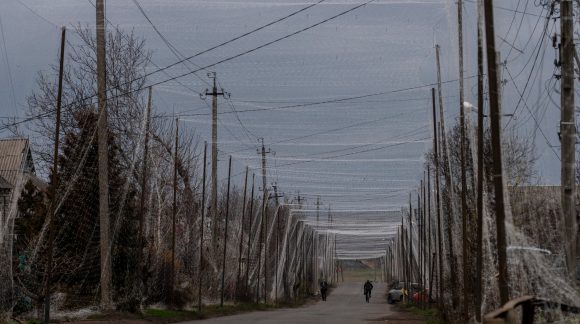Ukrainian journalist Vyacheslav Tverdokhlib, who lived in Mariupol when the full-scale invasion started, managed to smuggle a flash drive with photos and videos from the occupied city to Ukraine’s free territory in a candy.
He told Radio Liberty about his experiences in the besieged city.
He decided to leave Mariupol for the free territory of Ukraine in March 2022. Tverdokhlib walked 30 kilometers on foot.
The journalist was able to take a flash drive with hundreds of photos and videos taken in the city, hidden inside a candy. Later, this footage of Russia’s war crimes – bodies in the city’s boulevards, the fire in the drama theater, the aftermath of airstrikes – went viral globally.
On the eve of February 24, 2022, Vyacheslav worked at the municipal TV channel “TV7”. In the first days of the full-scale invasion, he left his own apartment and moved to the volunteer hub Khalabuda. He and other men delivered food and water to basements and bomb shelters where the locals where hiding from shelling.
The journalist tried to record everything he saw in the streets of Mariupol with his phone: “I was filming what I saw, what was happening. The airstrikes were frequent back then, constant shelling. They were firing at us from everything, even using naval aviation. It was impossible to film on camera. First, because of how eclectic it all was, and secondly, some people, say, lining for humanitarian aid would react aggressively.”
The journalist noted that he was aware that some shots ha had taken in the streets of the city had historical value: the bodies of people in the city’s boulevards, the aftermath of Russian strikes.
“I saw dead bodies in the streets. It was a very widespread thing to see. At public transport stops, and one dead man lay for a very long time by the ‘Thousand Trinkets’ (a store. – Ed.). At the bus stop on Metalurhiv Avenue there was an elderly woman wrapped up, in a sled… She had a name and an address written on her. Under the bridges, near the tower, where people would carry the corpses. On benches in parks, on playgrounds. They would take them out there. There were a lot of corpses. People tried to bury them, but the ground was frozen. They would bury them right in the yards of their houses or in shell craters. Those whose identities were known, those who were buried by their neighbors, had their graves signed. Others – no…” the journalist recalled.
Vyacheslav also remarked that it was historically important that he had managed to film something that only existed for a short while. “I realized that it must be filmed, because it would either be destroyed later, or they would make so that it’s no longer there. The city that existed before February 24 will forever remain in our memory. Even after the city is liberated, something will be cleared away, something will be rebuilt. Which is why we have to show everything they did there,” he believes.
The journalist’s decision to flee was made later, when there was a filming near the volunteer hub. On March 19, there was fighting in the streets in the neighborhood. And then people with white armbands – Russian soldiers – came to the volunteers.
Vyacheslav and his colleagues were taken for questioning. He says they were beaten, and one of the detainees was shot in the arm.
“There was a house near ‘Khalabuda’, they dragged us there for questioning. You follow them and you don’t know how much time you have left to live: a minute, a second, two, three. They asked, ‘Do you know where the SBU are hiding,’ ‘Did you serve in the army,’ they looked at our tattoos, examined our fingers, undressed us. They were looking for UAF soldiers, Azov fighters. They were Russians, the military. It was evident from their stance. They punched me with a machine gun when they saw an Instagram photo of our trip to the Azov base – we were presenting the new uniform. I tried the coat on, so they thought I was a soldier,” Vyacheslav said, adding that they were offered to become collaborators.
On March 22, Vyacheslav, a friend and his mother took off to leave Mariupol. They walked for almost three days, carefully bypassing the occupiers’ checkpoints on field roads. They were able to take a flash drive with photos and videos about the events in Mariupol with them by hiding the flash drive inside a candy.
“We took a large blanket that the three of us could cover ourselves with. A backpack. Documents. That’s it. My volunteer colleague and his mother were with me. I had photos and videos from Mariupol on my phone. And the boy’s 60-year-old mother had a flash drive – and I uploaded my content to the flash drive. I was most afraid for the flash drive, it would be a pity to lose it, so many shots! To smuggle it through the roadblocks, I came up with an idea to hide it inside a candy. My friend’s mother had some candies. I held one in my hands for a bit, in my pocket, so that it would melt a little. The bar was the size of two finger batteries – I hid the flash drive inside it. My friend’s mother then took it to France as she evacuated,” the journalist said.
They reached the Ukraine-controlled territory on March 25, in Vilnyansk. From there he got to Zaporizhzhia, where he still lives. Vyacheslav Tverdokhlib submitted his photos and videos to the Museum of the History of War in Kyiv, which took care of the international promotion. The Mariupol man’s photos traveled around the world.
“The Mariupol Drama Theater, the bodies of people in the boulevard, a concrete block overturned by an explosion, and the graffiti ‘The Russian world was here’ – these are the most telling shots, in my opinion. The first exhibition was in Poland, in Gdansk, in the open air, where the street was renamed – on both sides of the Russian consulate. There were banners with captions. I explained what was in the photos and listed the approximate date. 12 banners, this is a permanent exhibition, it is there today, too. Then there were exhibitions in Sweden, in Turkey, in other countries around the world,” says Vyacheslav.
The journalist is officially an IDP and continues to work for the Mariupol municipal television as a regional correspondent. He has made multiple trips to the hot spots of the front line, filmed the Ukrainian military, as well as the cities that were hit by shelling.


